“Possibly most important, only humans, not cardiac monitors, can determine the goals of monitoring for an individual patient with guidance from doing close cardiac EKG monitoring.”
American Heart Association
“Possibly most important, only humans, not cardiac monitors, can determine the goals of monitoring for an individual patient with guidance from doing close cardiac EKG monitoring.”
American Heart Association

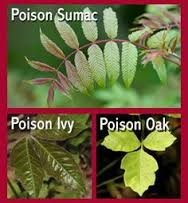
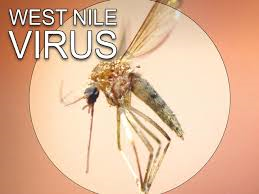
“Dehydration and heatstroke go hand in hand,” says Peter Galier, MD, associate professor of medicine at the David Geffen School of Medicine at UCLA. “It happens most commonly in people who are out in the sun.”
What happens, explains Galier, is that people sweat and replace their lost electrolyte-packed body fluids with only water. Dehydration can soon follow, and heatstroke can set in if a person becomes so dehydrated they can’t sweat enough to cool down, and their body temperature rises.
How to avoid it. “If you are outside and sweating, you should be drinking at least a 50-50 mix of Gatorade and water, which has potassium and sodium,” Galier tells WebMD. “You need to be drinking at least one small liter bottle of this mix every hour if you’re working or exercising in the sun.”
Warning signs. “Symptoms of dehydration can run the gamut from thirst and general fatigue, to headaches, nausea, and confusion,” says Galier. “Heatstroke symptoms are also headache and confusion, but include delirium and even hallucinations.”
What to do. While mild dehydration can be treated by rehydrating with fluids, heatstroke is more serious. “If you have heatstroke, you need to go to the emergency room so you can have intravenous fluids,” says Galier. “With really bad heatstroke, your kidneys can shut down.”
The old adage still rings true, explains Galier. “Leaves of three — let them be,” he says. So when the summer months begin, plan ahead when you know you’re going to be trekking through the woods.
Remember the old adage: “Leaflets three, let them be.” Poison ivy and poison oak have a triple-leaf structure you can learn to recognize — and then avoid.
Remember poison oak is more allergenic than poison ivy and poison oak is poison sumac, a deciduous woody shrub or small tree that grows 5–20 feet tall and has a sparse, open form. It inhabits swamps and other wet areas, pine woods, and shady hardwood forests. In Florida, poison sumac has been confirmed in the north and central regions, as far south as Polk County.
Figure 10.
Poison sumac leaves consist of 7–13 leaflets arranged in pairs with a single leaflet at the end of the midrib. Distinctive features include reddish stems and petioles (Figure 10). Leaflets are elongated, oval, and have smooth margins. They are 2–4 inches long, 1–2 inches wide, and have a smooth, velvety texture. In early spring, the leaves emerge bright orange. Later, they become dark green and glossy on the upper leaf surface and pale green on the underside. In the early fall, leaves turn a brilliant red-orange or russet shade
How to avoid it. “Poison ivy or oak is a tri-leafed plant, usually with a little yellow and purple, and it tends to be anywhere with shrubbery, hiding out with other vegetation,” says Galier. “So stay out of shrub areas or wear high boots or high socks, stay on the path, and don’t touch anything you don’t recognize.” You find both in the woods also.
Warning signs. Poison ivy, oak or sumac can creep up on you, even if you wear head-to-toe clothing. “It’s the oil of the leaf that’s the problem,” says Galier. “If you take your clothes off and you touch your clothes, you’re going to get it.” The “it” he’s referring to is the itching and swelling.
What to do. It’s time to get out the topical anti-itching cream again, like calamine lotion. “If you can suffer through it and it doesn’t get worse, you can ride it out,” says Galier. If it gets worse, you’ll need to see a doctor for topical steroids or oral steroids.”
Have you ever wondered: Can I get poison ivy? What you’re really asking is: Am I allergic to the plant? Not everyone is. Up to 85% of Americans are allergic to poison ivy, leaving at least 15% resistant to any reaction.
If you are allergic to poison ivy, you’re more likely to be allergic to poison oak and poison sumac, because all three plants contain the same rash-triggering plant oil called urushiol (pronounced yoo-ROO-shee-all). You’re also more likely to have an allergic reaction to other plant resins, such as the oil from Japanese lacquer trees (used on furniture), mango rinds, and cashew shells.
Sensitivity to poison ivy, poison oak, and poison sumac varies from a mild to severe reaction, and may not cause any reaction at all the first time you’re exposed. Some adults who reacted to poison ivy as children may find that they are now less sensitive. Some may even lose their sensitivity altogether.
Many people break out in a rash when urushiol touches the skin. And even if you don’t recall touching the leaves of poison ivy, oak, or sumac, you may have unwittingly come in contact with their roots or stems.
Urushiol quickly penetrates the skin, often leaving red lines that show where you brushed against the plant. Symptoms appear 24 to 72 hours after exposure. Scratching the itchy rash doesn’t cause it to spread but can prolong skin healing and cause a secondary infection. The rash isn’t contagious, so you won’t spread it to others by going to school or work.
Symptoms, which generally last from one to two weeks, include:
Does it matter which plant you’re exposed to? NO unless you know Poison ivy, oak, and sumac all fall into the plant species called Toxicodendron, so the allergic reaction to all of these plants has the same name: Toxicodendron dermatitis. There are actually four poisonous plants in this group, since poison oak has both a western and an eastern variation. All four plants contain urushiol, so the skin reaction and treatment are essentially the same.
Poison ivy, oak, and sumac are generally diagnosed by their common symptoms of a rash, blisters, and itching following activity outside in a forest or field, but if you have any doubt, ask your doctor.
What’s the treatment for any 3:
Call your doctor or a dermatologist for:
Get immediate medical help for any difficulty breathing or severe coughing after exposure to burning plants.
In some cases, an oral steroid or other medication may be needed to relieve severe symptoms.
Transmission can occur in one of three ways:
While mosquito bites used to be little more than annoying and itchy bumps on your arm or behind your ear, now we have even more reason to avoid them with things like West Nile virusand Triple E (Eastern equine encephalitis) making headlines.
How to avoid it. Your attack against a mosquito bite is three-pronged, according to the CDC’s web site: “Use insect repellent, particularly those with DEET, picaridin, or oil of lemon eucalyptus; wear as much clothing as the warm weather will allow; and avoid the outdoors during dusk and dawn — peak biting times.”
Warning signs. Mosquito bites will appear as red, raised bumps on your skin. Worse, they’ll itch.
What to do. Mosquito bites usually go away in less than a week, according to the web site of the University of Maryland Medical Center. In the meantime, you can wash the area and keep it clean, use an ice pack or a cool compress to alleviate itching, take an antihistamine, or use an anti-itching cream, such as calamine lotion.
Nearly 80% of people infected with West Nile virus will not have any symptoms. If you start to experience symptoms like fever, headache, body aches, nausea, vomiting, and sometimes swollen lymph glands or a skin rash on the chest, stomach, and back, according to the CDC’s web site, see your doctor. There’s a chance these could be symptoms of West Nile virus.
Swimmer’s ear is a kid’s nightmare when summer finally arrives.
“Just like when your fingers get pruney when you’re in the water too long, the same thing happens to your ears,” says Galier.
When you swim, or even shower or bathe, water can get trapped in your ear canal, causing the canal to get inflamed and infected.
How to avoid it. Gone are the days of Silly Putty in your ears. Now it’s simply wax ear plugs, or custom-fit ear plugs, explains Galier, to prevent swimmer’s ear.
Warning signs. “The symptoms of swimmer’s ear are ear pain and decreased hearing,” says Galier.
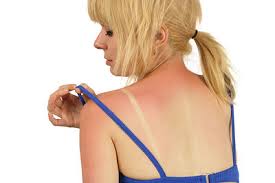
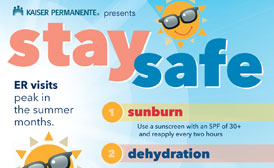
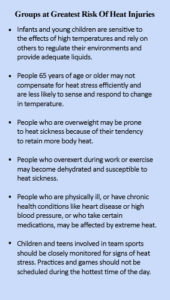
People’s biggest mistake by far is drinking and boating. People get out there and drink alcohol all day in the sun, and you end up with the same accidents you have with driving — with the added risks of falling out of boats, getting hit by propellers, and drowning.
It’s also easy to get lax about life jackets. Kids need to have them on all the time. Even if having them under the seat fulfills the law, in an accident, chances are anyone who doesn’t know how to swim won’t be able to get to them in time. When you are going to be out on a boat or at the beach with a child, you take on the responsibility to maintain the safety of that child and basic lifesaving skills are a must, not a luxury; especially for parents. The courses are easy, usually just one day or half a day and you may save your child’s LIFE or the child you take the responsibility in caring for. There’s no mouth-to-mouth [resuscitation] anymore if you are not trained — just chest compressions but if you get BCLS certified (basic care in life support) your CPR certified.
You can find first aid, cardiopulmonary resuscitation (CPR), and other emergency lifesaving courses near you with the American Heart Association’s ECC (Emergency Cardiovascular Care) Class Connector tool online at americanheart.org. or near you where you live.
We know almost every homeowner loves the sight of a pristine, neatly mowed yard. But in their haste to get that lawn in shape, some people forget to take precautions. “In the warmer months we see lots of mower injuries to toes, hands, and fingers getting caught in blades, and things like rocks and sticks getting flung out of them. People will start tinkering with the mower and reach under it to unclog it, and forget there’s a spinning blade there or take the key out when going under to see what clogged the blade from working. Those can be preventative moves and result in hideous injuries for some permanent and with others temporary.
They’re also hard to repair, because not only can whirling blades cause complex lacerations and fractures, but they can bury contaminants like grass and dirt in the wound putting the wound at risk for infection. To be safe:
Wear closed-toed shoes — preferably with a steel toe — when you mow, along with goggles or sunglasses, gloves, and long pants that will protect you from flying debris.
Keep kids away from the push mower and off the riding mower. Riding mowers are not just another ride-on toy.
Get a professional to service your mower or learn how to do it properly. Important: Disconnect the spark plug to prevent it from accidentally starting. Turning a push mower’s blade manually can ignite the engine.
You’ve romped outdoors with the kids all day, and your water bottle ran dry long ago. Suddenly you feel dizzy and lightheaded, and your mouth tastes like cotton. You’re dehydrated — meaning you haven’t taken in enough fluids to replace those you’ve been sweating out.
People can get dehydrated any time of year, but it’s much more common in the summer months, when they are active outdoors in the warm sun. Heatstroke is the most severe form of dehydration. That’s when your internal temperature rises to dangerously high levels. Your skin gets hot, but you stop sweating. Someone with heatstroke may pass out, have hallucinations, or suffer seizures.
Preventing dehydration and heatstroke is so easy: Drink plenty of fluids, especially water, take regular breaks in the shade, and try to schedule your most vigorous outdoor activities for times when the heat isn’t so strong, such as early morning or late afternoon.
For persons suffering more serious dehydration or heatstroke, get them indoors, have them lie down, and cool them off with ice packs and cool cloths. Someone who is seriously affected by the heat may need intravenous fluids in the ER.
With all the skin cancer warnings, you’d think Americans would be getting fewer sunburns, not more. But you’d be wrong. The percentage of adults nationwide who got at least one sunburn during the preceding year rose from 31.8% in 1999 to 33.7% in 2004, according to the CDC.
Your risk for melanoma doubles if you’ve had just five sunburns in your life. A sunburn is a first-degree burn, right up there with thermal burns. Also, we even see some second-degree thermal burns, often when people are out drinking or falling asleep in the sun and don’t realize how long they’ve been out there.
In addition to practicing “safe sun” — wearing sunscreen that protects against both UVB and UVA rays, long-sleeved shirts, and wide-brimmed hats, and staying out of blistering midday rays — there are things you can do to treat a severe sunburn, Stanton says:
-Drink water or juice to replace fluids you lost while sweating in the hot sun.
-Soak the burn in cool water for a few minutes or put a cool, wet cloth on it.
-Take an over-the-counter pain reliever, such as acetaminophen.
-Treatitching with an OTC antihistamine cream or a spray like diphenhydramine (such as Benadryl), which helps block the inflammatory reaction.
-Apply an antibiotic ointment or an aloe cream with emollients that soften and soothe the skin directly to the burned area.
-You’re going to have a pretty miserable 12 to 24 hours with the initial symptoms no matter what you do.
Food poisoning puts about 300,000 people in the hospital every year, hitting its peak in the summer months. You don’t want diarrhea to be the souvenir of your family’s annual summer picnic.
Anything that has mayonnaise, dairy, or eggs in it and any meat products can develop some pretty nasty bacteria after only a couple of hours unrefrigerated. Every summer we’ll have five or six people coming in from the same reunion or family picnic with food poisoning symptoms.
To prevent food poisoning, follow the U.S. Department of Agriculture’s advice to:
Mild cases of food poisoning can be cared for at home. Avoid solid foods, and stick with small, frequent drinks of clear liquid to stay hydrated. Once the nausea and vomiting have eased, you can try bringing food back into your diet — slowly and in small, bland portions (Grandma knew what she was talking about when she recommended tea and toast to settle an upset stomach). If symptoms persist for more than a couple days (or more than 24 hours in small kids), see a doctor.
Independence Day arrives. Many people love fireworks, but fireworks don’t necessarily love them back. Nearly 9,000 individuals were injured by fireworks in 2009, according to the U.S. Fire Administration, and two were killed. We see pretty significant hand and eye injuries from fireworks every summer. The safest way to watch fireworks is at a professionally sponsored display. At least six states ban all consumer fireworks, and several more allow them only with limitations. But if you can buy fireworks legally and want to set off a few at home, take these precautions:
To care for a fireworks burn, wrap it in a clean towel or T-shirt saturated with cool water and get to an emergency room to have the injury checked out.
“People who are physically active, eat a healthy diet, do not use tobacco, and practice other healthy behaviours reduce their risk for chronic diseases and have a much reduced rate of disability compared to others who don’t do this lifestyle.”
British Columbia Ministry of Health
I am enjoying my adulthood journey and wish I could say the same for many of our aging population. What I am observing as a RN, daughter and friend I must say it is a concern to me…why do people of age want to home in on talking about their illness (s) and making it their main topic of conversation? I can understand when a crisis happens, there is a new diagnosis that is heavy on their mind and that there stages they go through (shock, grieving, angry, bargaining, depression and acceptance) but I am not talking about this. I am talking about the need to focus on the aging process as a loss and a ‘giving up’ instead of looking at it for what it is… a time of a new stage in life from 40 and on some sooner where your process of mind and physical body goes through changes that can offer freedom, curiousity, and enjoyment. Let me give you some examples.
A family member of mine is in the last stage (I know I am not there but almost 30 years of care with geriatrics I have an idea how many live, some healthy with going about each day with a form of a work out or others closed in a box in their own world. There are conditions that slow us down but don’t cripple us and having a condition that isn’t curable many can be kept under controll. Though many like my family member give in or give up to the condition because or are set in their ways set to no change not paying attention to what they ate or stop exercise and the amount they eat. By doing this behavior what develops is weight gain and the signs started showing up of further health conditions like obesity, adult diabetes II (occurs 45 and up roughly), cardiac disease that would have never had occurred if the individual balance rest, a form of light exercise and good diet eating. On top of that from the immobility of sitting in the house or wherever you may sit all day gives you also sedentary lifestyle=less tone to the muscles with less muscle and more fat and stiffening of the muscle and joints that increases the risk of pulling a muscle or back which did to my family member, at first. Now over 6 years uses a cane and can barely walk with sciatica damage and the MRI and CatScan recently done only supposedly shows arthritis. Prevent this people just through a routine of balancing rest, exercise program (intense or slight work out = only 15 minutes a day), and good healthy dieting and high probability you will live longer with a better healthy tone body. The KEY to obtaining this is start YOUNG and you will get into this as a routine and it will feel like it’s a regular part of your life with you wanting to do it but if your elderly you can still do it. It maybe harder but go about it with your primrary MD’s approval with reviewing what is ok for a daily 15 minute exercise with proper dieting balancing this with rest. When he have a chance to correct obesity and prevent disease situations grab the opportunity before it is too late and unbearable to exercise, get out of the house, and now you sit in the house with few nearby to come and visit or even want to. Like many other family members and families in the world going through this that ill one limits the places they can go, limits independence (they have to be driven long distances 30 minutes away, have to do there shopping etc…). Where when they had there independence with having conversations with them other than there condition made you more out to look forward to visiting them. It’s just normal. Same example as if having a long term friend or sister you hung with for decades parting and gossiping and eating out and shopping together now moves into adulthood married with children. Than this sister depends on you for babysitting frequently, driving or picking the kids up frequently from school events, gossips about how bad the marriage is for 6 years now. Like anything else negativism all the time seen and heard you don’t want to be around. It is unfortunate but true. You on the other side feel obligated to do so for all the years of good life with that person but life good be better in the end if that family person doesn’t put themselves in that situation but it doesn’t always work that way. So make your life better and don’t but yourself in that situation. I am very much tryng to do so. One way of reaching it is through good diet (treats now and than), good exercise, and balance with good rest; doesn’t always work that way with work but I try to make up for it. My family member by diet alone, could help the situation. One by making good diet decisions and don’t eat after 5pm or 6pm and good healthy food. Don’t have a dinner 9pm at night; or usually big meals after 6pm and make smaller meals.
I was very patient when I learned about the family member changes 6 years ago with no progress just the opposite to even activities of daily living capabilities and than what go me was that member getting use to it and being drawn in to live that way where it’s like a addition now. This can definitely end your life sooner so it is up to you.he had to change his eating habits, monitor his blood sugar, and learn to give himself insulin shots. I understood it would take him time to adjust, so his constant talking and yes, even complaining, was expected. As a friend, it was my job to help that loved individual go through this transition and give the needed support to ease all the changes that the family member would have to go through.
So, here’s his story now. That member is less than 81 years old and has had this condition for several years, continues to make this health issue the topic of conversation to me, family members, and friends even when things are going really well. The fact is, this condition for getting close to 10 years, my family member, has chosen to play the ‘poor me scenario’ at times it appears to come across as. The doctor and myself as a RN almost 30 years has provided excellent information and several resources to help with coping. In only took me 6 years with some family sibling help to have her agree it’s time to move out of the house I grew up in since 1966. No one else lives in that house.
It is taking a toll on my psychic energy. In other words, it sucks the life right out of me and, after visiting, I am tired after 14 hours working and so ready to take a nap.
I see this with other friends going through a similar situation with some family member also. They talk about their arthritic aches and pains plus stiffness in their joints as much as they do about the changes in the weather. These are chronic conditions, meaning they will experience this from time to time, and talking about it obsessively won’t change a thing.
At what point do people decide that the aging process means they need to constantly talk about their health issues? At what point do they stop engaging in healthier topics of conversation? What are the reasons for this shift in how they converse with people and, more importantly, do they even realize how depressing this whole routine is?
Again being a RN around geriatrics I understand. One reason may actually be major depression (also known as clinical depression) , which is a medical illness. It is a chemical imbalance in the brain and can appear in people regardless of age, race or economic status. The illness can appear after a triggering event or for no apparent reason at all or simple normal with being alone by yourself (possible spouse deceased, friends moving if not dying off as age progresses) but when will the stop? At this point I highly doubt it and for me writing with some exercise busy in work and a good love life all help out.
TO HELP YOU DETECT THIS EARLY OR EVEN POSSIBLY STOP IT.
Look for signs of:
I too, have minor health issues, however I chose to acknowledge approaching it like this ‘it is what it is’, as my love says. I have been dealt this hand and therefore in my optimal level I will do what I can to not let it slow me down. The other side to the coin is how you look at that ½ glass of water. It can be I have the worst condition and play “feel sorry for me scenario” not even realizing it since it it talked about all the time or like I look at life there are so many worse of then me with disease, no home, no family, no friends and just surviving possibly getting a meal each day, if that. As I said, I am an observer of people partly because I am an RN and it’s part of my job. I have made note that those individuals who are really struggling with major health issues many hardly complain at all. They keep a positive attitude and, in doing so, don’t let their condition stop them from enjoying life or start a negative domino effect that just keeps dropping on top of another till it crashes all of them and unfortunately when continues to have a life spreading to others with that effect you turn them away. Like everyone else we all have our headaches and on high probability in adulthood health issues with losses and aches & pains. You have to deal with them in a positive note. Meaning don’t blame the world or someone else for your health situation unless its real and lack of moving around (going out) even 10 minutes exercise a day or 2 to 3 times a week one hour exercise for elderly (just simply walking) with good dieting and rest will take you along way. Going the opposite way gives you a shorter life and highier odds a unhappier with lonely life. Along with keeping a positive attitude, you may also find things that attract your likes as opposed to dislikes which will keep you busier in life and people benefit from being around cheerful positive people that attracts them to have you back more.
Not to far away from being elder in about 15 to 20 years, I hope to stir the Pagan (polytheistic or open minded) community to take notice of how they choose to age. Are we aging with grace or are we just aging? Talk to the God and Goddess for help in modifying your way of thinking so you can handle life’s little ups and down. If you have family and / or friends who are displaying this type of behavior, show empathy and love by helping them comprehend the negative effects that persist when they chose to concentrate on their health issues in a pessimistic way. Sometimes it becomes a habit and they don’t even realize how often it occurs.
Behaviors can be changed, so make up your mind to age with GRACE and not just age.
“None of God’s Creatures absolutely consider’d are in their own Nature Contemptible; the meanest Fly, the poorest Insect has its Use and Vertue.”
Mary Astell (12 November 1666 – 11 May 1731) was an English feminist writer and rhetorician. Her advocacy of equal educational opportunities for women has earned her the title “the first English feminist.
“Researchers have even frozen scorpions overnight, only to put them in the sun the next day & have seen them come to life with walking away. But there is one thing scorpions have a difficult time living without—soil. There burrowing creatures. These creatures live in every country but Antarctica.”
National Geographic
“The hallmark of myasthenia gravis is muscle weakness that increases during periods of activity and improves after periods of rest. Certain muscles such as those that control eye and eyelid movement, facial expression, chewing, talking, and swallowing are often, but not always, involved in the disorder. The muscles that control breathing and neck and limb movements may also be affected.”
The National Institute of Neurological Disorders and Stroke
“Men with the following factors are more likely to develop benign prostatic hyperplasia: age 40 years and older, family history of benign prostatic hyperplasia, medical conditions such as obesity/heart and circulatory disease/type 2 diabetes, lack of physical exercise and erectile dysfunction.”
The National Institute of Diabetes, and Digestive and Kidney Diseases.